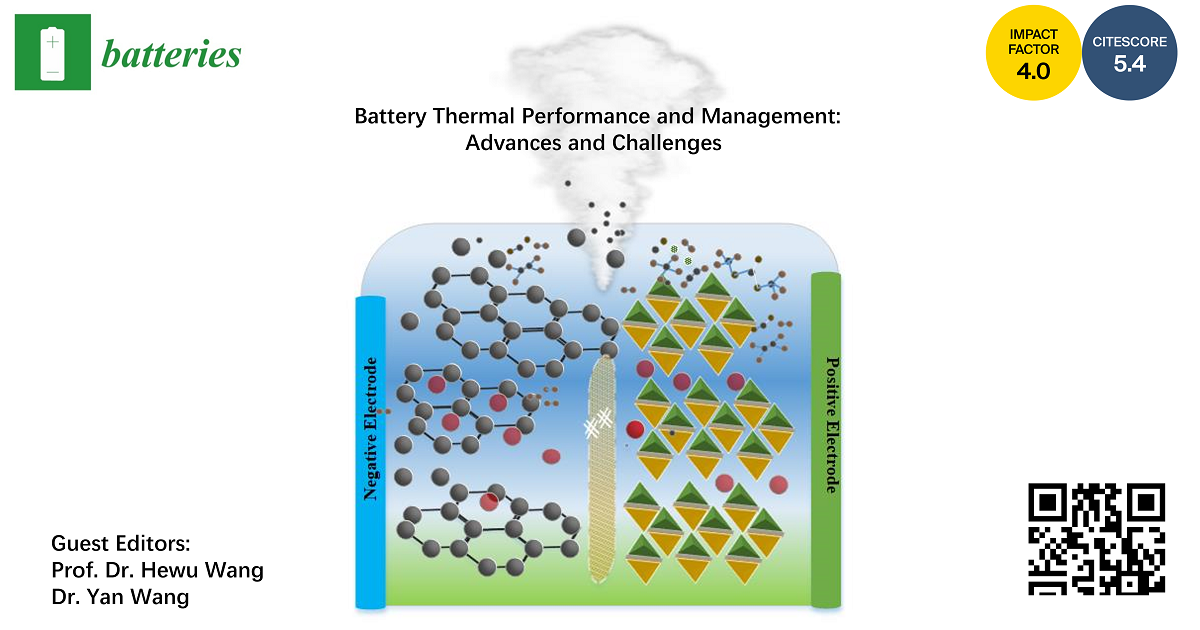Battery Thermal Performance and Management: Advances and Challenges
A special issue of Batteries (ISSN 2313-0105). This special issue belongs to the section "Battery Performance, Ageing, Reliability and Safety".
Deadline for manuscript submissions: 17 March 2025 | Viewed by 8827

Special Issue Editors
Interests: optimization of battery performance; passive safety
Interests: battery thermal management; thermal safety control
Special Issues, Collections and Topics in MDPI journals
Special Issue Information
Dear Colleagues,
The electrochemical properties and internal reactions of Li-lithium batteries are highly sensitive to operating temperatures. Inappropriate temperature conditions can result in a sharp rise in battery temperature, accelerating internal chemical reactions. Moreover, this can lead to thermal runaway, compromising the reliability and safety of electrical vehicle/ship/airplane battery packs and battery energy storage systems, thereby causing a significant loss of life and property. Additionally, temperature differences in the thermal field distribution between cell–module–pack configurations can reduce the available capacity, shorten the cycle life, and increase the risk of fire. Therefore, the implementation of battery thermal management strategies holds significant theoretical value and provides application guidance for the safe and reliable operation of battery systems; these strategies include cooling/heating methods, which ensure uniformity in the thermal–electrical field, and early warning systems that monitor behavior and offer protection against thermal hazards.
Topics
- Thermal decomposition reaction for electrode and electrolyte;
- Thermal management design (heating/ cooling by liquid, air, etc.);
- Electric vehicle or battery energy storage system integration thermal management strategies (battery, motor, HVAC, etc.);
- Thermal–electrical field uniformity control;
- Thermal runaway tests and behavior;
- Failure battery venting characteristics;
- Battery fire risk assessment and tests;
- Thermal hazard protection design and method;
- Battery thermal runaway modeling method and simulation.
Prof. Dr. Hewu Wang
Dr. Yan Wang
Guest Editors
Manuscript Submission Information
Manuscripts should be submitted online at www.mdpi.com by registering and logging in to this website. Once you are registered, click here to go to the submission form. Manuscripts can be submitted until the deadline. All submissions that pass pre-check are peer-reviewed. Accepted papers will be published continuously in the journal (as soon as accepted) and will be listed together on the special issue website. Research articles, review articles as well as short communications are invited. For planned papers, a title and short abstract (about 100 words) can be sent to the Editorial Office for announcement on this website.
Submitted manuscripts should not have been published previously, nor be under consideration for publication elsewhere (except conference proceedings papers). All manuscripts are thoroughly refereed through a single-blind peer-review process. A guide for authors and other relevant information for submission of manuscripts is available on the Instructions for Authors page. Batteries is an international peer-reviewed open access monthly journal published by MDPI.
Please visit the Instructions for Authors page before submitting a manuscript. The Article Processing Charge (APC) for publication in this open access journal is 2700 CHF (Swiss Francs). Submitted papers should be well formatted and use good English. Authors may use MDPI's English editing service prior to publication or during author revisions.
Keywords
- battery cooling/heating
- integration thermal management
- thelma-electric field uniformity
- battery thermal runaway
- battery venting characteristic
- battery fire risk assessment
- thermal hazard proportion
- battery thermal runaway modeling
Benefits of Publishing in a Special Issue
- Ease of navigation: Grouping papers by topic helps scholars navigate broad scope journals more efficiently.
- Greater discoverability: Special Issues support the reach and impact of scientific research. Articles in Special Issues are more discoverable and cited more frequently.
- Expansion of research network: Special Issues facilitate connections among authors, fostering scientific collaborations.
- External promotion: Articles in Special Issues are often promoted through the journal's social media, increasing their visibility.
- e-Book format: Special Issues with more than 10 articles can be published as dedicated e-books, ensuring wide and rapid dissemination.
Further information on MDPI's Special Issue polices can be found here.






